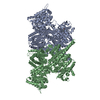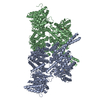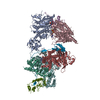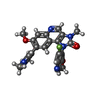+ Open data
Open data
- Basic information
Basic information
| Entry | Database: PDB / ID: 7ni4 | ||||||||||||||||||||||||||||||||||||||||||||||||||||||||||||||||||||||||||||||||||||||||||||||||||||||
|---|---|---|---|---|---|---|---|---|---|---|---|---|---|---|---|---|---|---|---|---|---|---|---|---|---|---|---|---|---|---|---|---|---|---|---|---|---|---|---|---|---|---|---|---|---|---|---|---|---|---|---|---|---|---|---|---|---|---|---|---|---|---|---|---|---|---|---|---|---|---|---|---|---|---|---|---|---|---|---|---|---|---|---|---|---|---|---|---|---|---|---|---|---|---|---|---|---|---|---|---|---|---|---|
| Title | Human ATM kinase domain with bound M4076 inhibitor | ||||||||||||||||||||||||||||||||||||||||||||||||||||||||||||||||||||||||||||||||||||||||||||||||||||||
 Components Components | Serine-protein kinase ATM | ||||||||||||||||||||||||||||||||||||||||||||||||||||||||||||||||||||||||||||||||||||||||||||||||||||||
 Keywords Keywords | SIGNALING PROTEIN / Kinase / inhibitor / DNA damage response / cancer research | ||||||||||||||||||||||||||||||||||||||||||||||||||||||||||||||||||||||||||||||||||||||||||||||||||||||
| Function / homology |  Function and homology information Function and homology informationestablishment of RNA localization to telomere / positive regulation of telomerase catalytic core complex assembly / negative regulation of telomere capping / Sensing of DNA Double Strand Breaks / cellular response to nitrosative stress / peptidyl-serine autophosphorylation / establishment of protein-containing complex localization to telomere / meiotic telomere clustering / positive regulation of telomere maintenance via telomere lengthening / pre-B cell allelic exclusion ...establishment of RNA localization to telomere / positive regulation of telomerase catalytic core complex assembly / negative regulation of telomere capping / Sensing of DNA Double Strand Breaks / cellular response to nitrosative stress / peptidyl-serine autophosphorylation / establishment of protein-containing complex localization to telomere / meiotic telomere clustering / positive regulation of telomere maintenance via telomere lengthening / pre-B cell allelic exclusion / male meiotic nuclear division / histone mRNA catabolic process / DNA-dependent protein kinase activity / extrinsic component of synaptic vesicle membrane / regulation of telomere maintenance via telomerase / histone H2AXS139 kinase activity / female meiotic nuclear division / DNA double-strand break processing / lipoprotein catabolic process / regulation of autophagosome assembly / cellular response to X-ray / V(D)J recombination / pexophagy / oocyte development / Impaired BRCA2 binding to PALB2 / reciprocal meiotic recombination / DNA repair complex / positive regulation of DNA damage response, signal transduction by p53 class mediator / Homologous DNA Pairing and Strand Exchange / Defective homologous recombination repair (HRR) due to BRCA1 loss of function / Defective HDR through Homologous Recombination Repair (HRR) due to PALB2 loss of BRCA1 binding function / Defective HDR through Homologous Recombination Repair (HRR) due to PALB2 loss of BRCA2/RAD51/RAD51C binding function / Resolution of D-loop Structures through Synthesis-Dependent Strand Annealing (SDSA) / Resolution of D-loop Structures through Holliday Junction Intermediates / 1-phosphatidylinositol-3-kinase activity / HDR through Single Strand Annealing (SSA) / response to ionizing radiation / positive regulation of double-strand break repair / Impaired BRCA2 binding to RAD51 / mitotic spindle assembly checkpoint signaling / negative regulation of B cell proliferation / TP53 Regulates Transcription of Caspase Activators and Caspases / cellular response to stress / mitotic G2 DNA damage checkpoint signaling / TP53 Regulates Transcription of Genes Involved in Cytochrome C Release / peroxisomal matrix / Presynaptic phase of homologous DNA pairing and strand exchange / replicative senescence / signal transduction in response to DNA damage / Regulation of HSF1-mediated heat shock response / somitogenesis / Pexophagy / ovarian follicle development / regulation of cellular response to heat / cellular response to retinoic acid / negative regulation of TORC1 signaling / positive regulation of telomere maintenance via telomerase / telomere maintenance / positive regulation of cell adhesion / DNA damage checkpoint signaling / Stabilization of p53 / thymus development / regulation of signal transduction by p53 class mediator / Autodegradation of the E3 ubiquitin ligase COP1 / post-embryonic development / determination of adult lifespan / double-strand break repair via homologous recombination / cellular response to reactive oxygen species / TP53 Regulates Transcription of DNA Repair Genes / DNA damage response, signal transduction by p53 class mediator / Regulation of TP53 Activity through Methylation / Nonhomologous End-Joining (NHEJ) / HDR through Homologous Recombination (HRR) / cellular response to gamma radiation / G2/M DNA damage checkpoint / brain development / DNA Damage/Telomere Stress Induced Senescence / Meiotic recombination / double-strand break repair via nonhomologous end joining / spindle / multicellular organism growth / Regulation of TP53 Degradation / intrinsic apoptotic signaling pathway in response to DNA damage / cellular senescence / Recruitment and ATM-mediated phosphorylation of repair and signaling proteins at DNA double strand breaks / site of double-strand break / double-strand break repair / positive regulation of neuron apoptotic process / Processing of DNA double-strand break ends / chromosome / heart development / protein autophosphorylation / neuron apoptotic process / Regulation of TP53 Activity through Phosphorylation / regulation of apoptotic process / protein phosphorylation / non-specific serine/threonine protein kinase / regulation of cell cycle / regulation of autophagy / positive regulation of cell migration Similarity search - Function | ||||||||||||||||||||||||||||||||||||||||||||||||||||||||||||||||||||||||||||||||||||||||||||||||||||||
| Biological species |  Homo sapiens (human) Homo sapiens (human) | ||||||||||||||||||||||||||||||||||||||||||||||||||||||||||||||||||||||||||||||||||||||||||||||||||||||
| Method | ELECTRON MICROSCOPY / single particle reconstruction / cryo EM / Resolution: 3 Å | ||||||||||||||||||||||||||||||||||||||||||||||||||||||||||||||||||||||||||||||||||||||||||||||||||||||
 Authors Authors | Stakyte, K. / Rotheneder, M. | ||||||||||||||||||||||||||||||||||||||||||||||||||||||||||||||||||||||||||||||||||||||||||||||||||||||
| Funding support |  Germany, 4items Germany, 4items
| ||||||||||||||||||||||||||||||||||||||||||||||||||||||||||||||||||||||||||||||||||||||||||||||||||||||
 Citation Citation |  Journal: Nat Struct Mol Biol / Year: 2021 Journal: Nat Struct Mol Biol / Year: 2021Title: Molecular basis of human ATM kinase inhibition. Authors: K Stakyte / M Rotheneder / K Lammens / J D Bartho / U Grädler / T Fuchß / U Pehl / A Alt / E van de Logt / K P Hopfner /  Abstract: Human checkpoint kinase ataxia telangiectasia-mutated (ATM) plays a key role in initiation of the DNA damage response following DNA double-strand breaks. ATM inhibition is a promising approach in ...Human checkpoint kinase ataxia telangiectasia-mutated (ATM) plays a key role in initiation of the DNA damage response following DNA double-strand breaks. ATM inhibition is a promising approach in cancer therapy, but, so far, detailed insights into the binding modes of known ATM inhibitors have been hampered due to the lack of high-resolution ATM structures. Using cryo-EM, we have determined the structure of human ATM to an overall resolution sufficient to build a near-complete atomic model and identify two hitherto unknown zinc-binding motifs. We determined the structure of the kinase domain bound to ATPγS and to the ATM inhibitors KU-55933 and M4076 at 2.8 Å, 2.8 Å and 3.0 Å resolution, respectively. The mode of action and selectivity of the ATM inhibitors can be explained by structural comparison and provide a framework for structure-based drug design. | ||||||||||||||||||||||||||||||||||||||||||||||||||||||||||||||||||||||||||||||||||||||||||||||||||||||
| History |
|
- Structure visualization
Structure visualization
| Movie |
 Movie viewer Movie viewer |
|---|---|
| Structure viewer | Molecule:  Molmil Molmil Jmol/JSmol Jmol/JSmol |
- Downloads & links
Downloads & links
- Download
Download
| PDBx/mmCIF format |  7ni4.cif.gz 7ni4.cif.gz | 568 KB | Display |  PDBx/mmCIF format PDBx/mmCIF format |
|---|---|---|---|---|
| PDB format |  pdb7ni4.ent.gz pdb7ni4.ent.gz | 430.3 KB | Display |  PDB format PDB format |
| PDBx/mmJSON format |  7ni4.json.gz 7ni4.json.gz | Tree view |  PDBx/mmJSON format PDBx/mmJSON format | |
| Others |  Other downloads Other downloads |
-Validation report
| Summary document |  7ni4_validation.pdf.gz 7ni4_validation.pdf.gz | 1.2 MB | Display |  wwPDB validaton report wwPDB validaton report |
|---|---|---|---|---|
| Full document |  7ni4_full_validation.pdf.gz 7ni4_full_validation.pdf.gz | 1.3 MB | Display | |
| Data in XML |  7ni4_validation.xml.gz 7ni4_validation.xml.gz | 91.8 KB | Display | |
| Data in CIF |  7ni4_validation.cif.gz 7ni4_validation.cif.gz | 137 KB | Display | |
| Arichive directory |  https://data.pdbj.org/pub/pdb/validation_reports/ni/7ni4 https://data.pdbj.org/pub/pdb/validation_reports/ni/7ni4 ftp://data.pdbj.org/pub/pdb/validation_reports/ni/7ni4 ftp://data.pdbj.org/pub/pdb/validation_reports/ni/7ni4 | HTTPS FTP |
-Related structure data
| Related structure data |  12350MC  7ni5C  7ni6C C: citing same article ( M: map data used to model this data |
|---|---|
| Similar structure data |
- Links
Links
- Assembly
Assembly
| Deposited unit | 
|
|---|---|
| 1 |
|
- Components
Components
| #1: Protein | Mass: 351127.688 Da / Num. of mol.: 2 Source method: isolated from a genetically manipulated source Source: (gene. exp.)  Homo sapiens (human) / Gene: ATM / Production host: Homo sapiens (human) / Gene: ATM / Production host:  Homo sapiens (human) Homo sapiens (human)References: UniProt: Q13315, non-specific serine/threonine protein kinase #2: Chemical | #3: Chemical | Has ligand of interest | Y | Has protein modification | N | |
|---|
-Experimental details
-Experiment
| Experiment | Method: ELECTRON MICROSCOPY |
|---|---|
| EM experiment | Aggregation state: PARTICLE / 3D reconstruction method: single particle reconstruction |
- Sample preparation
Sample preparation
| Component | Name: ATM dimer with bound KU-55933 / Type: COMPLEX / Entity ID: #1 / Source: RECOMBINANT |
|---|---|
| Source (natural) | Organism:  Homo sapiens (human) Homo sapiens (human) |
| Source (recombinant) | Organism:  Homo sapiens (human) Homo sapiens (human) |
| Buffer solution | pH: 7.5 |
| Specimen | Embedding applied: NO / Shadowing applied: NO / Staining applied: NO / Vitrification applied: YES |
| Vitrification | Cryogen name: ETHANE |
- Electron microscopy imaging
Electron microscopy imaging
| Experimental equipment |  Model: Titan Krios / Image courtesy: FEI Company |
|---|---|
| Microscopy | Model: FEI TITAN KRIOS |
| Electron gun | Electron source:  FIELD EMISSION GUN / Accelerating voltage: 300 kV / Illumination mode: FLOOD BEAM FIELD EMISSION GUN / Accelerating voltage: 300 kV / Illumination mode: FLOOD BEAM |
| Electron lens | Mode: BRIGHT FIELD |
| Image recording | Electron dose: 42 e/Å2 / Detector mode: COUNTING / Film or detector model: GATAN K2 SUMMIT (4k x 4k) |
- Processing
Processing
| Software | Name: PHENIX / Version: 1.19.1_4122: / Classification: refinement | |||||||||
|---|---|---|---|---|---|---|---|---|---|---|
| EM software |
| |||||||||
| CTF correction | Type: PHASE FLIPPING AND AMPLITUDE CORRECTION | |||||||||
| 3D reconstruction | Resolution: 3 Å / Resolution method: FSC 0.143 CUT-OFF / Num. of particles: 455866 / Symmetry type: POINT |
 Movie
Movie Controller
Controller













 PDBj
PDBj





















